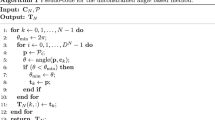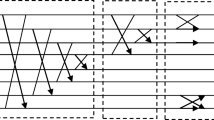Abstract
This paper presents the local cosine transform (LCT) as a new method for the reduction and smoothing of the blocking effect that appears at low bit rates in image coding algorithms based on the discrete cosine transform (DCT). In particular, the blocking effect appears in the JPEG baseline sequential algorithm.
Two types of LCT were developed: LCT-IV is based on the DCT type IV, and LCT-II is based on DCT type II, which is known as the standard DCT. At the encoder side the image is first divided into small blocks of pixels. Both types of LCT have basis functions that overlap adjacent blocks. Prior to the DCT coding algorithm a preprocessing phase in which the image is multiplied by smooth cutoff functions (or bells) that overlap adjacent blocks is applied. This is implemented by folding the overlap** parts of the bells back into the original blocks, and thus it permits the DCT algorithm to operate on the resulting blocks. At the decoder side the inverse LCT is performed by unfolding the samples back to produce the overlapped bells. The purpose of the multiplication by the bell is to reduce the gaps and inaccuracies that may be introduced by the encoder during the quantization step.
LCT-IV and LCT-II were applied on images as a preprocessing phase followed by the JPEG baseline sequential compression algorithm. For LCT-IV, the DCT type IV replaced the standard DCT as the kernel of the transform coding. In both cases, for the same low bit rates the blocking effect was smoothed and reduced while the image quality in terms of mean-square error became better. Subjective tests performed on a group of observers also confirm these results. Thus the LCT can be added as an optional step for improving the quality of existing DCT (JPEG) encoders. Advantages over other methods that attempt to reduce the blocking effect due to quantization are also described.
Similar content being viewed by others
References
W.K. Pratt, “Spatial transform coding of color images,”IEEE Trans. Commun., vol. COM-19, 1971, pp. 980–992.
N.S. Jayiant and P. Noll,Digital Coding of Waveforms, Prentice-Hall, Englewood Cliffs, NJ, 1984.
N. Ahmed, T. Natarjan, and K.R. Rao, “Discrete cosine transform,”IEEE Trans. Comput., vol. ⋯, 1974, pp. 90–93.
K.R. Rao and P. Yip,Discrete Cosine Transform, Academic Press, New York, 1990.
W. Chen, C.H. Smith, and S. Fralic, “A fast computational algorithm for the discrete cosine transform,”IEEE Trans. Commun. vol. COM-25, 1977, pp. 1004–1009.
H.S. Malvar, “Fast computations of the discrete cosine transform through fast Hartley transform,”Electron Lett., vol. 22, 1986, pp. 352–353.
F.A. Kamangar and K.R. Rao, “Fast algorithms for the 2D-discrete cosine transform,”IEEE Trans. Comput. vol. C-31, 1982, pp. 899–906.
W.H. Chen and C.H. Smith, “Adaptive coding of monochrome and color images,”IEEE Trans. Commun., vol. COM-25, 1977, pp. 1285–1292.
W.H. Chen and W.K. Pratt, “Scene adaptive coder,”IEEE Trans. Commun. COM-32, 1984, pp. 225–232.
Digital Compression and Coding of Continuous-Tone Still Images, Part 1: Requirements and Guidelines, ISO—IEC JTC1 Committee Draft 10918-1, February 1991.
Digital Compression and Coding of Continuous-Tone Still Images, Part 2: Compliance Testing, ISO—IEC JTC1 Committee Draft 10918-2, July 1991.
G.K. Wallace, “The JPEG Still Picture Compression,” pp. 31–44, Comm. of the ACM, vol. 34, No. 4, 1991.
H.S. Malvar and D.H. Staelin, “The LOT: Transform coding without blocking effects,”IEEE Trans. Acoust., Speech, Signal Process., vol. 37, 1989, pp. 553–559.
H.S. Malvar and D.H. Staelin, “Reduction of blocking effects in image coding with a lapped orthogonal transform,” inProc. ICASSP '88, New York, 1988, pp. 781–784.
H.C. Reeve III and J.S. Lim, “Reduction of blocking effect in image coding,”Opt. Eng., vol. 23, 1984, pp. ⋯
D.E. Pearson and M.W. Whybray, “Transform coding of images using interleaved blocks,”IEE Proc. Part F, vol. 131, 1984, pp. 466–472.
H.S. Malvar, “A pre-and post-filtering technique for the reduction of blocking effects,” presented at Picture Coding Symp., Stockholm, June 1987.
Z. Wang, “Fast algorithms for the discrete W transform and for the discrete Fourier transform,”IEEE Trans. Acoust., Speech, Signal Process., vol. ASSP-32, 1984, pp. 803–816.
H.S. Malvar, “The Lapped transforms for efficient transform/subband coding,”IEEE Trans. Acoust., Speech, Signal Process vol. 38, 1990, pp. 969–978.
R.R. Coifman and Y. Meyer, “Remarques sur l'analyse de Fourier à fenêtre,”C.R. Acad. Sci. Ser. I vol. 312, 1991, pp. 259–261.
Author information
Authors and Affiliations
Rights and permissions
About this article
Cite this article
Aharoni, G., Averbuch, A., Coifman, R. et al. Local cosine transform — a method for the reduction of the blocking effect in JPEG. J Math Imaging Vis 3, 7–38 (1993). https://doi.org/10.1007/BF01248401
Issue Date:
DOI: https://doi.org/10.1007/BF01248401




